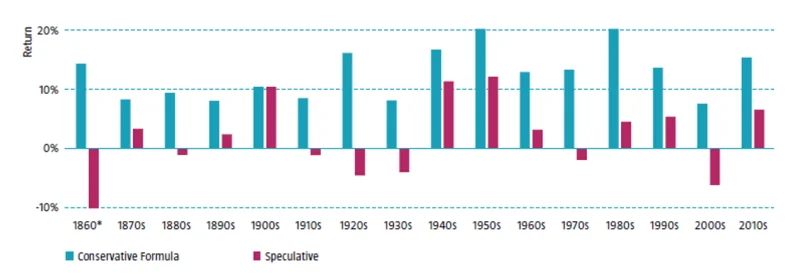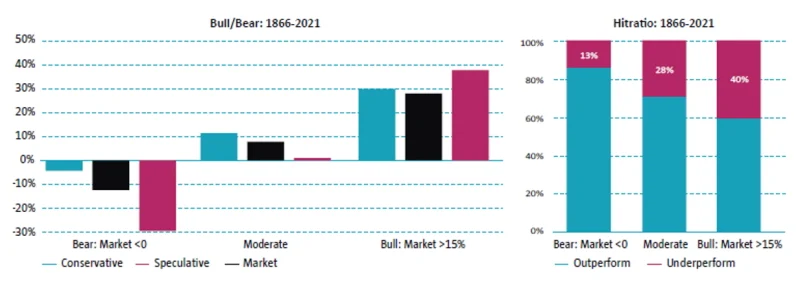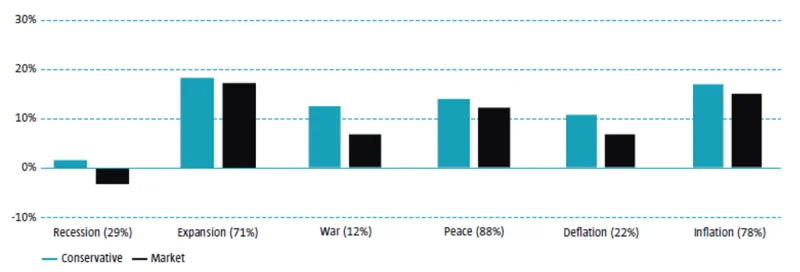Conservative strategies typically target market-beating long-term returns with lower downside risk by outperforming in down markets and broadly keeping pace in up markets. While the concept of a defensive approach clearly has its merits in an overall portfolio, it is important to test whether it holds up in practice.
In our recent study,1 we examined the performance of a simple rules-based conservative strategy over a period of more than 150 years (January 1866 to December 2021), using a novel US stock database created by Robeco researchers.2 This provided us with additional and unique insights given that the period before 1929 contained several boom-bust cycles, wars and periods of deflation.
For our investigation, we created low-risk or defensive strategies using an approach we term the ‘Conservative Formula’. This is based on a few rules:
From the largest 1,000 stocks, we select 500 with lowest volatility.
From this subset, we then choose 100 stocks with the best net-payout-yield and price momentum.
The resulting portfolio is then rebalanced on a quarterly basis.
By including net-payout-yield and price momentum, we create a more balanced defensive strategy that benefits from multiple alpha sources and avoids some of the pitfalls of low volatility investing, such as high valuations and weak momentum. This is also serves as a rough proxy for our Conservative Equities strategy.
Low-risk stocks outperform their high-risk peers
To begin with, we assessed how different portfolios sorted on volatility performed in the pre-1929 era and the entire sample period. Aside from the strategy based on the Conservative Formula, we used a ‘traditional’ low-risk approach by sorting the cross-section of stock returns into 10 portfolios on historical 36-month volatility. More specifically, the lowest decile portfolio contained stocks with the lowest volatility, while the highest decile portfolio contained stocks with the highest volatility.
As shown in Figure 1, the relationship between risk and return is negative over the 1866-1928 period as higher-risk portfolios underperformed their lower-risk counterparts. This means that taking additional risk on the stock market was not rewarded. The picture is broadly similar over the full sample period, albeit returns initially increase along with risk, before trending down again as the volatility increases. In general, this informs us that taking on more risk is not necessarily rewarded in the long run.
Figure 1 | Portfolios sorted on volatility

Source: Robeco Quantitative Research. Performance in USD gross of fees and costs.
Meanwhile, the portfolio based on the Conservative Formula generated higher-risk adjusted returns than the single-sorted volatility strategies. This was expected, given the integration of additional return factors. Over both sample periods, the average annualized return is about 2% to 3% higher than the three lowest-volatility portfolios, with similar volatility to the second and third-lowest volatility portfolios.
As such, the Conservative Formula leads to a defensive, high-return strategy as opposed to a minimum volatility portfolio. This is important in the context of achieving stable capital growth in the long run.
時刻把握我們最新市場觀點及電子報
接收荷寶電子報,率先閱讀最新洞察分析,並構建最綠色的投資組合。
Conservative stocks fare better than their speculative counterparts
We also investigated how a portfolio based on the Conservative Formula performed in each decade (except for the 1860s as our data only started in 1866), alongside a portfolio (speculative) on the opposite side of the spectrum, i.e., consisting of high volatility stocks with low net-payout yields and weak momentum. As depicted in Figure 2, conservative stocks delivered a positive annualized return in every decade, whereas their speculative counterparts achieved more mixed results. Moreover, conservative stocks beat their speculative peers in all periods.
Figure 2 | Annualized return of conservative and speculative stocks per decade

Source: Robeco Quantitative Research. Performance in USD gross of fees and costs.
Winning by losing less
As outlined earlier, defensive strategies typically achieve their long-term outperformance by preserving capital in down markets and participating meaningfully in up markets, i.e., they win by losing less in the long run. As illustrated in Figure 3, conservative stocks provided some downside protection during bear markets and kept up during bull markets over the full sample period. By contrast, their speculative peers outperformed during bull markets; however, this did not compensate for their losses during bear markets.
Figure 3 | Conservative Formula, speculative stocks and the market portfolio across bull/bear markets

Source: Robeco Quantitative Research. Performance in USD gross of fees and costs.
That said, it is important to note that while conservative stocks typically reduce losses in sell-off events, there are times when they do lag in bear markets. Indeed, the hit ratio for conservative stocks in bear markets over our sample period is 87%, which means that they delivered worse returns than the market over 13% of the time in down markets. To mention a few instances, we saw this play out during the start of the Spanish flu pandemic in 1917, the ‘panic of 1873’, and more recently, during the early phases of the Covid pandemic in 2020.
But as outlined, the conservative strategy reduced losses in most bear markets, and in the long run, it shows its true strength as the unexpected short-term periods of underperformance in down markets are effectively canceled out.
Resilience during recessions, wars, and deflation
Our deep 155-year sample also gave us the opportunity to study infrequent macro events. For instance, we have only seen a handful of recessions over the last 30 years, but they were quite common in the 19th century. Similarly, there are not many wartime periods we can reference in recent history, but over our sample period there were seven US wars – starting with the Spanish-US war and ending with the Iraq-US war. Inflationary episodes were also more common back then compared to the last 30 years (excluding 2021 onwards). As shown in Figure 4, conservative stocks have generally exhibited resilience in periods that coincided with recession, expansion, peace, war, deflation or inflation.
Figure 4 | Conservative Formula and the market portfolio across regimes: 1866 to 2021

Source: Robeco Quantitative Research. Performance in USD gross of fees and costs.
Conclusion
Given our findings, we conclude that conservative, low-risk stocks typically provide stable and high long-term returns as they ‘win by losing less’. Their attributes of preserving capital in down markets and participating meaningfully in up markets are key ingredients for long-term capital growth.
Thanks to the results seen over the long sample period dating back to the 19th century, we believe it is highly unlikely that the high alpha generated by conservative stocks is down to luck. In fact, the approach works across different time periods and market structures. In our view, this means that the low-risk anomaly is not dependent on a specific regime or market environment. Therefore, we believe the case for a long-term strategic allocation to conservative stocks remains strong.
免責聲明
本文由荷宝海外投资基金管理(上海)有限公司(“荷宝上海”)编制, 本文内容仅供参考, 并不构成荷宝上海对任何人的购买或出售任何产品的建议、专业意见、要约、招揽或邀请。本文不应被视为对购买或出售任何投资产品的推荐或采用任何投资策略的建议。本文中的任何内容不得被视为有关法律、税务或投资方面的咨询, 也不表示任何投资或策略适合您的个人情况, 或以其他方式构成对您个人的推荐。 本文中所包含的信息和/或分析系根据荷宝上海所认为的可信渠道而获得的信息准备而成。荷宝上海不就其准确性、正确性、实用性或完整性作出任何陈述, 也不对因使用本文中的信息和/或分析而造成的损失承担任何责任。荷宝上海或其他任何关联机构及其董事、高级管理人员、员工均不对任何人因其依据本文所含信息而造成的任何直接或间接的损失或损害或任何其他后果承担责任或义务。 本文包含一些有关于未来业务、目标、管理纪律或其他方面的前瞻性陈述与预测, 这些陈述含有假设、风险和不确定性, 且是建立在截止到本文编写之日已有的信息之上。基于此, 我们不能保证这些前瞻性情况都会发生, 实际情况可能会与本文中的陈述具有一定的差别。我们不能保证本文中的统计信息在任何特定条件下都是准确、适当和完整的, 亦不能保证这些统计信息以及据以得出这些信息的假设能够反映荷宝上海可能遇到的市场条件或未来表现。本文中的信息是基于当前的市场情况, 这很有可能因随后的市场事件或其他原因而发生变化, 本文内容可能因此未反映最新情况,荷宝上海不负责更新本文, 或对本文中不准确或遗漏之信息进行纠正。
